IV Think of yourself as a practical psychologist. Make up a short presentation about the ways to boost self-confidence
V Translate the following into English:
1. Невербальная коммуникация – это сложный процесс, включающий в себя слова, интонацию голоса и движения тела.
2. Я испытываю к нему беспричинную неприязнь. Это наверно все из-за того, что он пятится бочком, ходит сгорбленно.
3. Отыскать ключ ко всем неразрешенным загадкам стало больше чем привычка и требует большой концентрации.
4. Спрятать признаки напряжения, овладеть мастерством и уверенностью над окружающей обстановкой, и ты почувствуешь себя уверенно.
5. Хождение прямо может выразить больше значения чем слова в разговоре и придать гораздо больше смысла взаимоотношениям.
6. Их схожесть в позе – лишь подделка.
VIII Answer the following questions:
- What is body language?
- Can you really convey anything without words?
- What is more important: words or body language?
- What would you believe if words say one thing while body language conveys the opposite?
- How can knowing body language help you?
- Is it possible to learn body language?
- Does walking tall produce an image of being confident while slouched posture means lack of confidence?
- What is postural echo?
- Do you agree that there’s a similarity of posture and gestures among friends?
- How can you understand that a person is lying with the help of body language?
- What is more important in body language: movements, facial features, eyes, lips…
- Should we underestimate the power of body language – is it essential to know?
- What barrier/submission/aggression/expansion/encroachment signals do you know?
- Do all nationalities possess some typical gestures?
- What is their origin?
- Is there at least one international gesture in the world?
- Should we underestimate our gestures while being in some foreign country?
- Is it possible to fake body language? What for?
BODY LANGUAGE
A. It’s common knowledge that human communication consists not only of sounds or written symbols. It also takes place by the use of gestures, postures, positions and distances. Actually, in many situations, non-verbal communication can reveal more accurately what a person is feeling. Body language always speaks the truth, whereas words may often be misleading.
Nowadays much of our basic non-verbal behaviour is learned and the meaning of many movements and gestures is culturally determined. Let us now look at some aspects of body language:
| 1. When people are happy they smile. | 2. When they are sad or angry they frown or scowl. |
| 3. Nodding the head is almost universally used to indicate ‘yes’ or affirmation. | 4.  “Boredom”. When the listener begins to use his hand to support his head, it is a signal that he is bored and his supporting hand is an attempt to hold his head up to stop himself from falling asleep. “Boredom”. When the listener begins to use his hand to support his head, it is a signal that he is bored and his supporting hand is an attempt to hold his head up to stop himself from falling asleep. |
5.   “Steepling hands”. This gesture means confidence. But be attentive, the movements preceding the steeple gesture will show you whether this confidence is positive or negative. “Steepling hands”. This gesture means confidence. But be attentive, the movements preceding the steeple gesture will show you whether this confidence is positive or negative. | 6.  When the index finger points vertically up the cheek and the thumb supports the chin, the listener is having negative or critical thoughts about the speaker or his subject. When the index finger points vertically up the cheek and the thumb supports the chin, the listener is having negative or critical thoughts about the speaker or his subject. |
7. 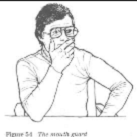 “The mouth guard”. If the person who is speaking uses this gesture, it indicates that he is telling a lie. If, however, he covers his mouth while you’re speaking it indicates that he feels you are lying! Sometimes this gesture may only be several fingers over the mouth, a closed fist or even a fake cough but its meaning remains he same. “The mouth guard”. If the person who is speaking uses this gesture, it indicates that he is telling a lie. If, however, he covers his mouth while you’re speaking it indicates that he feels you are lying! Sometimes this gesture may only be several fingers over the mouth, a closed fist or even a fake cough but its meaning remains he same. | 8. 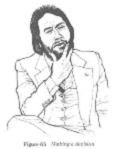 The person is making a decision The person is making a decision |
9. 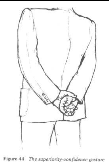 “Palm-in-palm position”. This is a superiority / confidence gesture. If you take this position when you’re in a high stress situation, such as being interviewed or simply waiting outside a dentists’s surgery, you will feel quite relaxed, confident and even authoritative. “Palm-in-palm position”. This is a superiority / confidence gesture. If you take this position when you’re in a high stress situation, such as being interviewed or simply waiting outside a dentists’s surgery, you will feel quite relaxed, confident and even authoritative. | 10.  “Folded arms”. This gesture shows that people feel uncertain or insecure. When the listener folds his arms he has not only more negative thoughts about the speaker but he’s also less attentive to what is being said. “Folded arms”. This gesture shows that people feel uncertain or insecure. When the listener folds his arms he has not only more negative thoughts about the speaker but he’s also less attentive to what is being said. |
11.  “The eye rub”. This is the brain’s attempt to block out the decit, doubt or lie that it sees or to avoid having to look at the face of the person to whom he telling the lie. “The eye rub”. This is the brain’s attempt to block out the decit, doubt or lie that it sees or to avoid having to look at the face of the person to whom he telling the lie. | 12.  This gesture show that the user is “cool”, he has a self-confident attitude and a feeling of protection. This gesture show that the user is “cool”, he has a self-confident attitude and a feeling of protection. |
13. 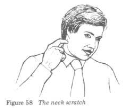 “The neck scratch”. The index finger of the writing hand scratches below the earlobe, or may even scratch the side of the neck. This gesture is a signal of doubt or uncertainty and is characteristic of the person who says, “I’m not sure I agree.” “The neck scratch”. The index finger of the writing hand scratches below the earlobe, or may even scratch the side of the neck. This gesture is a signal of doubt or uncertainty and is characteristic of the person who says, “I’m not sure I agree.” | 14.  “Leg cross position”. This may be a signal that a negative attitude or nervousness may exist. However, this is usually a supportive gesture that occurs with other negative gestures and shouldn’t be interpreted in isolation or out of context. “Leg cross position”. This may be a signal that a negative attitude or nervousness may exist. However, this is usually a supportive gesture that occurs with other negative gestures and shouldn’t be interpreted in isolation or out of context. |
15. 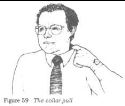 “The Collar pull”. Some people use this gesture when they tell a lie and suspect that they have been caught out. It’s also used when a person is feeling angry or frustrated and needs to pull the collar away from his neck in an attempt to let cool air circulate around it. “The Collar pull”. Some people use this gesture when they tell a lie and suspect that they have been caught out. It’s also used when a person is feeling angry or frustrated and needs to pull the collar away from his neck in an attempt to let cool air circulate around it. | 16.  “Picking imaginary lint”. This is one of the most common signals of disapproval and when the listener continually picks imaginary pieces of lint off his clothing it is a good indication that he doesn’t like what is being said, even though he may be verbally agreeing with everything. “Picking imaginary lint”. This is one of the most common signals of disapproval and when the listener continually picks imaginary pieces of lint off his clothing it is a good indication that he doesn’t like what is being said, even though he may be verbally agreeing with everything. |
17. 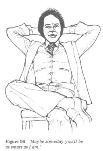 “Hands behind head posture”. This positionis typical for people who are feeling confident, dominant or superior about something. If we could read the person’s mind he would be saying something like, “I have all the answers”, or “May be one day you’ll be as smart as I am”, or even “Everything’s under control.” “Hands behind head posture”. This positionis typical for people who are feeling confident, dominant or superior about something. If we could read the person’s mind he would be saying something like, “I have all the answers”, or “May be one day you’ll be as smart as I am”, or even “Everything’s under control.” | 18.  “Open palms”. Throughout history open palms have been associated with truth, honesty and submission. When people wish to be totally open, truthful or honest they will hold one a both palms out to the other person. Sometimes they expose only part of the palms. Like most body language this is a completely unconscious gesture, one that gives you a feeling that the other person has a positive attitude to you and is telling a truth. “Open palms”. Throughout history open palms have been associated with truth, honesty and submission. When people wish to be totally open, truthful or honest they will hold one a both palms out to the other person. Sometimes they expose only part of the palms. Like most body language this is a completely unconscious gesture, one that gives you a feeling that the other person has a positive attitude to you and is telling a truth. |
B. Situation:
At the end of the XX century the humanity was witnessing the emergence of a new kind of social scientists – the non-verbalist. Just as the birdwatcher delights in watching birds and their behaviour, so the non-verbalist delights in watching the non-verbal gestures and signals of human beings. He is a student of behaviour who wants to learn about the actions of his fellow humans so that he and then people all over the world may learn more about themselves and how they can improve their relationships with others.
Today Mr. Allan Pease and Mr. Julius Fast, behavioural scientists on non-verbal communication, are invited to a TV show to talk about body language and its importance in everyday life. They are going to be shown some video records and asked to comment on the non-verbal aspects of face-to-face encounters.
Role-Assignments:
1 You are a TV programme host. You are to lead the discussion helping the invited scientists to share their points of view.
2, 3You are Mr. Allan Pease and Mr. Julius Fast, scientists on non-verbal communication
a) Speak about body language, tell the audience what personal benefits people have if they know how to read other’s thoughts by their gestures.
b) When you watch several video scenes comment on the non-verbal cues the people are making while talking to each other and compare them with the verbal signals (the spoken words).
4, 5, 6 … You are actors. Play small scenes which are going to be shown to the non-verbalists. They watch you interacting at the office, at the beach, at home, at presentations, shops, parks or anywhere else. While communicating use different gestures, postures, body signals which show your feelings and what you really keep in mind. Your attitude towards each other may be other positive or negative. Demonstrate it with the help of body language.
